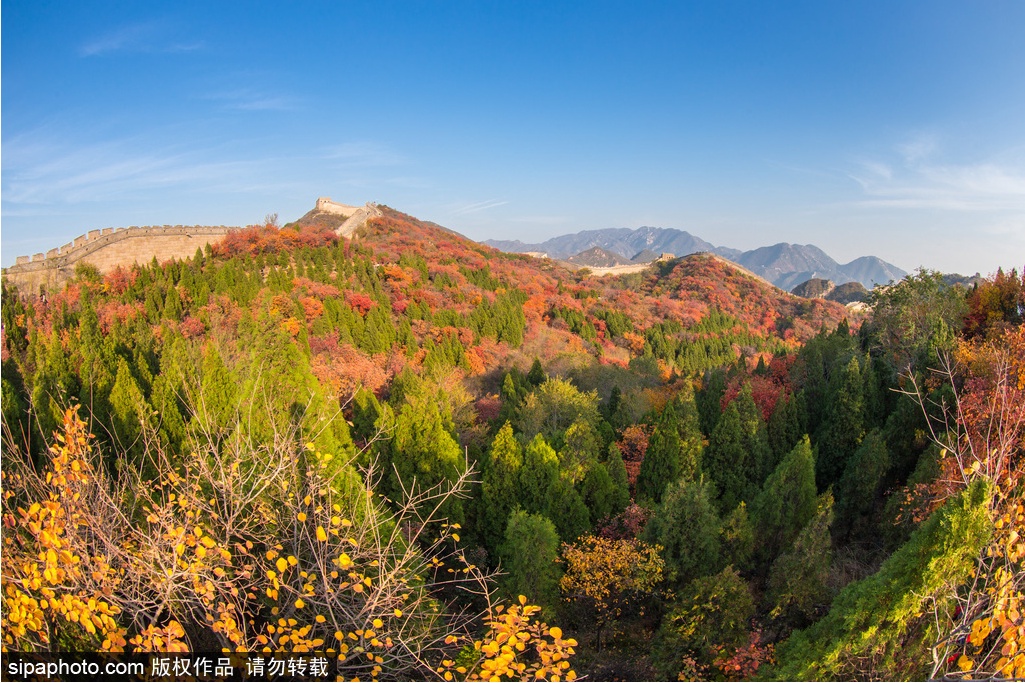Located at the northern end of Guangou Ancient Path, Jundu Mountain, Yanqing District, Beijing, Badaling Great Wall has been titled one of the “Nine Great Passes in the World”. It is the best preserved and the most representative section of the Great Wall of the Ming Dynasty, serving as the outpost of Juyong Pass, an important strategic pass of the Great Wall. Given that above, it is the first section of the Great Wall that opened to tourists.

Badaling Defensive Fort was built in the 18th year (1505) under the reign of Emperor Hongzhi of Ming Dynasty in a trapezoid shape whose west section is broader than the east section, and repaired during the reign of emperors Jiajing and Wanli of the Ming Dynasty. The east and west gate towers defense the Defensive Fort, respectively hanging the tablets inscribed “Juyong Waizhen” (means the strategic town outside Juyong Pass and was inscribed in the 18th year (1539) under the reign of Emperor Jiajing of the Ming Dynasty) and “Beimen Suoyue” (means the north spot of great military importance and was inscribed in the 10th year (1582) under the reign of Emperor Wanli of the Ming Dynasty). The two gate towers are masonry structure, with platforms on gate arches. Passages are built on north and south sides of the platforms to connect the Defensive Fort and crenels are built on four sides of the platforms.
The ancient proverb says that “The steepness of Juyong Pass does not lie in the Pass but Badaling”. Standing on a high position overlooking the ground below, this section of the Great Wall is steep and combines the beauty of lofty mountains and graceful scenery. After the restoration of its Defensive Fort and some city walls in 1953, it was open to the public as a sightseeing area. Having been renovated for several times, the Badaling Great Wall offers a tourist section of 3,741 m, including 1,176 m in the south and 2,565 m in the north, and 16 enemy fortification stations. In March 1961, the “Badaling section of the Great Wall” was identified as the first batch of cultural relics under state-level protection. In 1982, it was listed as a national key scenic spot. In 1986, it was officially awarded the top of national top-ten scenic spots. In 1987, it was ranked into the List of World Cultural Heritage by UNESCO. In 1992, it took the first place in the list of “World’s Best Scenic Spots in Beijing”. In 1995, it was named as a “National Patriotism Education Base” by China National Committee for the Wellbeing of the Youth. From 2000 to 2009, it attracted more than 500 heads of state, chiefs of government, and leaders of ruling party all over the world. On May 8, 2007, it was formally approved by the National Tourism Administration as a national 5A-level scenic area.
In addition to the Great Wall, Badaling scenic area also boasts a host of attractions, such as the Forest of Ancient Stone Tablets, the Stone Statue of Yang Yande (the fifth eldest son of Song Dynasty general Yang Ye in the Generals of the Yang Family legends), Stone Statues in Shifo Temple, Goldfish Pond, Chadaoliang, Qi Jiguang Scenic Park, Yuan Chonghuan Scenic Park, the Scenic Park of the Forest of Ancient Stone Tablets, and Chadao Ancient City. Currently, Badaling has initially formed a tour system with strong layered sense that focuses on the open section of the Great Wall, the China Great Wall Museum, and the Full View Cinema, and is supported by three free scenic parks, the remnant Great Wall, and Chadao Ancient City.
Self-driving: drive along the North 3rd Ring Road and transfer to Badaling Expressway at the entrance of Madian Bridge, and get off at Badaling Scenic Area
Line S2:
To give way to the maintenance of the Beijing-Zhangjiakou Railway, the new station of Huangtudian Station (the starting station of Line S2) is removed to the southeast side of the Huoying Subway Station.
Take subway at the city proper to Huoying Subway Station, and walk about 1 km to Huangtudian Station and take the Line S2 to Badaling Great Wall.



